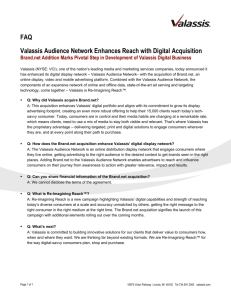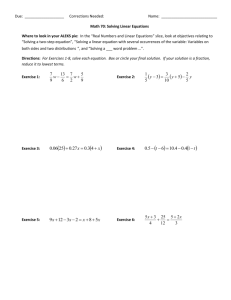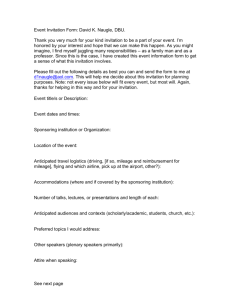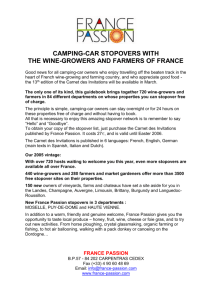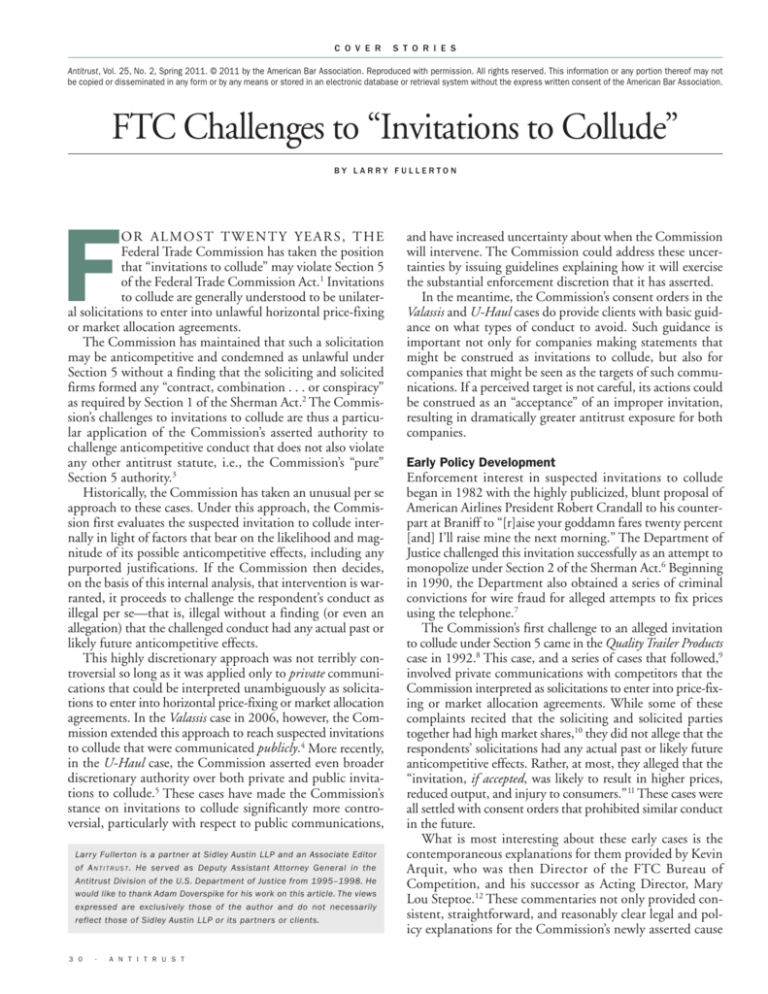
C O V E R
S T O R I E S
Antitrust, Vol. 25, No. 2, Spring 2011. © 2011 by the American Bar Association. Reproduced with permission. All rights reserved. This information or any portion thereof may not
be copied or disseminated in any form or by any means or stored in an electronic database or retrieval system without the express written consent of the American Bar Association.
FTC Challenges to “Invitations to Collude”
BY LARRY FULLERTON
F
OR ALMOST TWENTY YEARS, THE
Federal Trade Commission has taken the position
that “invitations to collude” may violate Section 5
of the Federal Trade Commission Act.1 Invitations
to collude are generally understood to be unilateral solicitations to enter into unlawful horizontal price-fixing
or market allocation agreements.
The Commission has maintained that such a solicitation
may be anticompetitive and condemned as unlawful under
Section 5 without a finding that the soliciting and solicited
firms formed any “contract, combination . . . or conspiracy”
as required by Section 1 of the Sherman Act.2 The Commission’s challenges to invitations to collude are thus a particular application of the Commission’s asserted authority to
challenge anticompetitive conduct that does not also violate
any other antitrust statute, i.e., the Commission’s “pure”
Section 5 authority.3
Historically, the Commission has taken an unusual per se
approach to these cases. Under this approach, the Commission first evaluates the suspected invitation to collude internally in light of factors that bear on the likelihood and magnitude of its possible anticompetitive effects, including any
purported justifications. If the Commission then decides,
on the basis of this internal analysis, that intervention is warranted, it proceeds to challenge the respondent’s conduct as
illegal per se—that is, illegal without a finding (or even an
allegation) that the challenged conduct had any actual past or
likely future anticompetitive effects.
This highly discretionary approach was not terribly controversial so long as it was applied only to private communications that could be interpreted unambiguously as solicitations to enter into horizontal price-fixing or market allocation
agreements. In the Valassis case in 2006, however, the Commission extended this approach to reach suspected invitations
to collude that were communicated publicly.4 More recently,
in the U-Haul case, the Commission asserted even broader
discretionary authority over both private and public invitations to collude.5 These cases have made the Commission’s
stance on invitations to collude significantly more controversial, particularly with respect to public communications,
Larry Fullerton is a partner at Sidley Austin LLP and an Associate Editor
of A N T I T R U S T . He ser ved as Deputy Assistant Attorney General in the
Antitrust Division of the U.S. Department of Justice from 1995–1998. He
would like to thank Adam Doverspike for his work on this article. The views
expressed are exclusively those of the author and do not necessarily
reflect those of Sidley Austin LLP or its partners or clients.
3 0
·
A N T I T R U S T
and have increased uncertainty about when the Commission
will intervene. The Commission could address these uncertainties by issuing guidelines explaining how it will exercise
the substantial enforcement discretion that it has asserted.
In the meantime, the Commission’s consent orders in the
Valassis and U-Haul cases do provide clients with basic guidance on what types of conduct to avoid. Such guidance is
important not only for companies making statements that
might be construed as invitations to collude, but also for
companies that might be seen as the targets of such communications. If a perceived target is not careful, its actions could
be construed as an “acceptance” of an improper invitation,
resulting in dramatically greater antitrust exposure for both
companies.
Early Policy Development
Enforcement interest in suspected invitations to collude
began in 1982 with the highly publicized, blunt proposal of
American Airlines President Robert Crandall to his counterpart at Braniff to “[r]aise your goddamn fares twenty percent
[and] I’ll raise mine the next morning.” The Department of
Justice challenged this invitation successfully as an attempt to
monopolize under Section 2 of the Sherman Act.6 Beginning
in 1990, the Department also obtained a series of criminal
convictions for wire fraud for alleged attempts to fix prices
using the telephone.7
The Commission’s first challenge to an alleged invitation
to collude under Section 5 came in the Quality Trailer Products
case in 1992.8 This case, and a series of cases that followed,9
involved private communications with competitors that the
Commission interpreted as solicitations to enter into price-fixing or market allocation agreements. While some of these
complaints recited that the soliciting and solicited parties
together had high market shares,10 they did not allege that the
respondents’ solicitations had any actual past or likely future
anticompetitive effects. Rather, at most, they alleged that the
“invitation, if accepted, was likely to result in higher prices,
reduced output, and injury to consumers.” 11 These cases were
all settled with consent orders that prohibited similar conduct
in the future.
What is most interesting about these early cases is the
contemporaneous explanations for them provided by Kevin
Arquit, who was then Director of the FTC Bureau of
Competition, and his successor as Acting Director, Mary
Lou Steptoe.12 These commentaries not only provided consistent, straightforward, and reasonably clear legal and policy explanations for the Commission’s newly asserted cause
of action, but they also acknowledged its limitations.
As described by Arquit, the “invitation prohibited in Trailer
Products was a nonpublic, straightforward solicitation which,
if accepted by the solicited party, would give rise to a per se
price-fixing violation.” 13 Characterizing this conduct as a
“naked” invitation to fix prices “utterly without efficiency justification,” Arquit defended the Commission’s summary
approach to condemning such solicitations on the basis that
it would deter price fixing without at the same time chilling
competitively benign or procompetitive behavior.14 According to Arquit, this created a “per se prohibition against solicitations to fix prices.” 15
To Arquit, the legal and policy rationale for this per se
approach suggested two limitations on its application. First,
the approach should not be applied to solicitations to enter
into agreements that were not per se illegal, such as a solicitation to enter into an agreement to form a legitimate joint
venture.16 Second, the per se approach should not be applied
to public invitations to collude. Arquit acknowledged that the
“fact that an invitation to collude is made in a public forum
should not, of course, immunize communications that harm
competition any more than a publicly arrived at agreement
automatically avoids liability under Section 1 of the Sherman
Act.” He noted, however, that a per se approach to ambiguous public statements could “inhibit procompetitive communications that only incidentally conveyed information to
competitors.” 17 He also noted that public speech is “more susceptible than private speech to detection by law enforcement
authorities, and is less likely to result in a secret agreement.” 18
For these reasons, Arquit believed that if public speech were
involved, “[m]arket structure analysis and legitimate efficiency justifications should be given full consideration.” 19
Steptoe likewise saw the Quality Trailer Products case as
establishing a per se approach to invitations to collude in the
context of private communications. She likewise cautioned
against extending this approach to “instances of public communications,” where there are “more likely to be efficiency justifications” and “the public nature of the communication itself
may cast doubt on a real collusive purpose or expectation.” 20
Arquit and Steptoe thus explained the Commission’s early
cases as establishing a per se rule of limited scope. For this rule
to apply, the communication must be private, and it must be
fairly interpreted as a solicitation to enter into a price-fixing
or market allocation agreement. When these conditions were
met, the conduct would be illegal per se, and the Commission would not need to demonstrate actual past or likely
future anticompetitive effects or (apparently) consider purported business justifications. In effect, the anticompetitive
effects associated with the solicitation would be presumed, just
as the law presumes anticompetitive harm from an actual
agreement to fix prices.
In all other cases, Arquit and Steptoe agreed, market structure and efficiency justifications should be given “full consideration,” presumably under a rule of reason analysis.21
This approach is consistent with subsequent commentators
who have argued that if the Commission wishes to challenge
public communications as invitations to collude, it should do
so only after taking into account market structure and possible efficiency justifications.22
The Commission’s early per se formulation was at the
time, and remains today, somewhat controversial, and it
might be difficult in a close case to characterize any given
course of conduct as a “straightforward” solicitation to enter
into a price-fixing or market allocation agreement. Nonetheless, this approach had the virtue of being a comparatively clear-cut rule for counseling purposes.23
Application to Public Communications in Valassis
The Commission’s policy approach lost this comparative
clarity when the Commission began to challenge public
communications as invitations to collude under Section 5,
starting with the Valassis case in 2006. According to the
Commission’s complaint in this case, the CEO of Valassis
Communications, a producer and distributor of discount
coupon booklets, extended an unlawful invitation to collude
to News America, its only competitor, in a conference call
with financial analysts.
Allegedly, the CEO of Valassis opened the call by stating
that Valassis planned to raise its floor price for full pages to
$6 per thousand to customers that might be considering
switching their business to or expanding their business with
Valassis. For a few days, Valassis would honor outstanding
bids to prospective customers at lower prices, but after a
specified date, all prospective customers would be quoted the
new, higher price. The CEO also stated that Valassis would
be monitoring News America’s response to this announcement and that, if News America did not raise its prices, the
parties’ recent price war would resume: “We expect that concrete evidence of News America’s intentions will be available
in the marketplace in short order. If News continues to pursue our customers and market share then we will go back to
our previous strategy.” 24
Although the communication in Valassis was public, the
Commission’s complaint tracked those in earlier cases involving private invitations to collude. For example, the Commission did not allege that the conduct that Valassis actually
engaged in, by itself, had any actual past or likely future anticompetitive effects. It did allege, however, that Valassis and
News America were the only two competitors in a market in
which entry was difficult and that the “invitation to collude,
if accepted by News America, would likely have resulted in
higher . . . prices and reduced output.” 25 The Commission
also alleged that Valassis acted with the intent to facilitate collusion and without a legitimate business justification.26
The Analysis of Agreement Containing Consent Order
released by the Commission in this case explained that while
previous Commission actions challenging invitations to collude have generally involved private communications, “the
fact of public communication should not, without more,
constitute a defense . . . .”27 At the same time, the ComS P R I N G
2 0 1 1
·
3 1
C O V E R
mission acknowledged that a variety of considerations should
enter into liability determinations in the context of public
communications, stating that liability should depend upon
“the substance and context of the communication, including
issues of intent, likely effect, and business justification, and
should not turn solely on the arena in which the communication occurs.” 28
With respect to Valassis, the Commission noted that the
market was characterized by “durable” or “longstanding
duopoly,” that Valassis communicated with its rival with
“extraordinary specificity,” and that “[m]uch of this information would not have been publicly communicated, even
to investors and analysts . . . but for Valassis’s effort to induce
collusion.” 29
The Commission also acknowledged that corporations
have “many obvious and important reasons for discussing
business strategies and financial results with shareholders,
securities analysts, and others” and that, for this reason, “the
Commission is extremely sensitive to the fact that antitrust
intervention involving a corporation’s public communications must take great care not to unduly chill legitimate
speech.” 30 In Valassis, however, the Commission determined
that the public statements went “far beyond” disclosure for
legitimate business reasons and presented a “substantial danger of competitive harm.” 31 Under such “limited circumstances,” the Commission said, it may challenge an invitation
to collude under Section 5, “even where the conduct did not
result in competitive harm.” 32
The Commission’s consent order prohibited Valassis from
inviting collusion or entering into any collusive scheme going
forward.33 However, in a proviso also included in the later
U-Haul order, the Commission permitted Valassis “publicly
to disclose any information . . . required by the Federal
Securities Laws.” 34
Expanded Per Se Rule
At first blush, the Valassis case may appear to have established
a traditional rule of reason approach to public invitations to
collude—but it did not. While the Commission acknowledged that liability in the context of public communications
should depend on a number of factors, including “likely effect
and business justification,” it adhered to its historical approach
and refrained from alleging any actual or likely anticompetitive effects in its complaint. Indeed, in its Analysis of Agreement Containing Consent Order, the Commission expressly
affirmed that it felt free to challenge invitations to collude
“even where the conduct did not result in competitive harm.”
Instead, Valassis established an unusual form of per se rule
under which the Commission may itself evaluate the factors
that bear on the likelihood and magnitude of anticompetitive
effects and any purported justifications for the challenged
conduct. If the Commission decides, based on its internal
analysis, that antitrust intervention is warranted, it may challenge the conduct without regard to its actual or likely effects.
This is best thought of as an extension of the Commission’s
3 2
·
A N T I T R U S T
S T O R I E S
earlier per se approach into the new context of public communications.35
Case Against U-Haul
The U-Haul case supports this characterization of the
Commission’s emerging analytic framework and can be read
to assert an even broader discretionary authority to decide
what is or is not anticompetitive and illegal. In that complaint, the Commission alleged that U-Haul, the largest consumer truck rental company in the United States, invited its
closest competitor, Avis Budget Group, Inc. (Budget) to join
with U-Haul in a collusive scheme to raise rates for one-way
truck rentals.
U-Haul involved both private and public communications. According to the complaint, U-Haul’s CEO instructed U-Haul’s regional managers and dealers to reach out privately to their counterparts at Budget to exhort them to
match U-Haul’s higher rates. A year later, U-Haul’s CEO
allegedly instructed managers to raise their rates, anticipating
that “Budget will come up.” 36 But Budget did not immediately follow. Then, during a conference call with stock analysts, in response to a question about U-Haul’s pricing strategies, U-Haul’s CEO explained that U-Haul was trying to
“show price leadership” for the good of the entire industry.37
He said that U-Haul was attempting to indicate to competitors, such as Budget, that they should not “throw the money
away,” and that they should “[p]rice at cost at least.” 38 The
CEO then indicated that he had instructed U-Haul managers
to wait a while longer for Budget to respond and that he was
optimistic that Budget would respond by raising prices:
[F]or the last 90 days, I’ve encouraged everybody who has
rate setting authority in the Company to give [it] more time
and see if you can’t get it to stabilize. In other words, hold the
line at a little higher.
And if they [Budget] perceive that we’ll let them come up a
little bit, I remain optimistic they’ll come up, and it has a
profound effect on us.39
In its complaint, the Commission did not distinguish
between U-Haul’s private and public communications.
Instead, the Commission alleged that “[e]ach and all” of
U-Haul’s communications established an invitation to collude, which, “if accepted by Budget, would likely result in
higher one-way truck rental rates and reduced output.” 40 As
in earlier cases, while the complaint stated that U-Haul and
Budget together accounted for a large percentage of the market, the Commission did not allege that U-Haul’s conduct
alone had any actual or likely anticompetitive effects.
According to the Analysis of Agreement Containing
Consent Order filed in the case, U-Haul’s conduct threatened
competitive harm because even an “unaccepted invitation to
collude may facilitate coordinated interaction by disclosing
the solicitor’s intentions and preferences.” 41 In particular, the
Commission felt that the improper communications from
U-Haul, including the public statements made by U-Haul’s
CEO, “could have encouraged Budget [or other competitors]
to raise rates.” 42 However, as indicated, the complaint did not
allege that any competitor had, in fact, raised its rates, and
nowhere did the Commission analyze the likelihood that
any competitor would attempt to raise rates, succeed at the
attempt, and thereby cause competitive harm.
Significantly, and again without distinguishing between
private and public communications, the Commission also
made clear that it was prepared to infer an actionable invitation to collude from “less egregious” conduct than was
present in U-Haul, stating: “It is not essential that the Commission find repeated misconduct attributable to senior
executives, or define a market, or show market power, or
establish substantial competitive harm, or even find that the
terms of the desired agreement have been communicated
with precision.” 43 Ultimately, the consent order in U-Haul
mirrored the Commission’s order in Valassis.
Valassis and U-Haul together appear to assert a broad discretionary authority on the part of the Commission. Whether
a suspected invitation to collude is extended in private or in
public, the Commission may itself evaluate and take into
account any factors it deems relevant to the liability determination before challenging the invitation under what is
essentially a per se rule.
Need for Commission Guidelines
One could reasonably object to the Commission’s broad
assertion of discretionary authority on policy grounds. Even
when the Commission sought to use Section 5 in the 1980s
to challenge the unilateral adoption of “facilitating practices”
(e.g., advance public announcements of future price changes)
the Commission acknowledged that it had to demonstrate
anticompetitive effects.44 At a minimum, the Commission’s
recent actions cry out for a more complete explanation than
is afforded by its publicly filed documents.45
As part of a broader debate about the scope of the Commission’s pure Section 5 authority, Commissioner William E.
Kovacic has called upon the Commission to issue a policy
statement or guidelines that would articulate a framework for
analyzing such cases and describe how the Commission will
exercise its asserted enforcement discretion.46 In part, this was
intended to help the Commission to win their pure Section
5 cases in court. But the need for guidelines exists even in the
comparatively established area of invitations to collude—
and for the same reasons. Taking up Commissioner Kovacic’s
call for guidelines would provide needed clarity for businesses and those who counsel them.
Such guidelines should address private and public invitations to collude separately. In each case, the Commission
should explain whether it is taking a per se or rule of reason
approach, and discuss its analytical framework. The Commission should explain under what circumstances it will presume
harm and which business justifications will be recognized
and when.
In the area of private solicitations to enter into price-fixing and market allocation agreements, the Commission’s tra-
ditional approach seems reasonably well-accepted,47 and little more may be required than to endorse the explanation and
the limitations already acknowledged by Arquit and Steptoe.
Where public invitations to collude are concerned, however,
at least three topics should be addressed, as follows.
First, the Commission should clarify the line between an
advance public announcement of a future price increase and
an invitation to collude that would be actionable under
Section 5. Presumably, an advance announcement of a price
increase alone cannot be an invitation to collude. If competitors “accept” the implied suggestion of a price increase
by raising their own prices, that conduct does not form an
agreement that could be challenged as illegal per se (indeed,
it is generally accepted that such conduct would not be
unlawful at all under Sherman Section 1).48 Even an advance
announcement of a price increase coupled with evidence of
a subjective intent to exercise price leadership should be
insufficient to constitute an invitation to collude.
Yet, in the U-Haul complaint, the Commission emphasized
that U-Haul had expressed the subjective desire to exercise
price leadership, as if that had special importance. Would
that have been sufficient, in the Commission’s view, to establish an invitation to collude? If not, what else would be needed? The U-Haul and Valassis cases suggest that the following
factors will strengthen the inference that a public communication constitutes an invitation to collude: (1) the competitor
being solicited is clearly identified; (2) the competitor being
solicited is the soliciting firm’s “closest” competitor; (3) the references to future prices and price policies are “specific;” (4) the
announced future price comes into or remains in effect only
if competitors respond by raising their prices; and/or (5) competitors are threatened with lower prices if they do not
respond. But it is not clear how these factors are to be evaluated or what happens if only some of the factors are present
in a given case or they point in different directions.
Second, the Commission should clarify the market characteristics that support an inference of likely anticompetitive
harm. As has been discussed, it is widely understood that liability for public communications should depend in part on
a showing that the market is already susceptible to express or
tacit collusion. In Valassis, the Commission acknowledged as
much, saying that liability should depend in part on the
“context of the communication” and emphasizing that the
market in that case was characterized by “durable duopoly.” 49
But it did not make clear the market characteristics that generally should be taken into account, nor did it establish
thresholds for those characteristics.
Finally, the Commission should clarify what justifications
it will recognize and in what circumstances. In Valassis, the
Commission acknowledged that corporations have “many
obvious and important reasons” for discussing business strategies and financial results with shareholders, securities analysts,
and others.50 But what are the reasons that the Commission
is prepared to recognize? In the consent orders in both Valassis
and U-Haul, the Commission appeared to recognize only
S P R I N G
2 0 1 1
·
3 3
C O V E R
one—the need to make disclosures “required” by the securities laws. Are there others? And what about disclosures that
are not required by the securities laws but nevertheless
advance their purposes? Indeed, some have argued that at
least some corporate disclosures are immune entirely from
antitrust challenge under the Supreme Court’s decision in
Credit Suisse v. Billing, where those disclosures advance the
purposes of the securities laws and fall within the scope of
federal securities regulatory authority.51
Rules of Thumb for Counselors
Even in the absence of definitive guidance from the Commission, there are a few rules of thumb that may be teased
out of the Valassis and U-Haul cases to provide clients with
basic guidance on avoiding unwelcome interest from the
Commission.
First, clients should be counseled not to contact competitors privately and say or write anything that could be construed as a solicitation to enter into a price-fixing or market
allocation agreement. A straightforward, private invitation to
collude is not a gray area; the Commission should be expected to take an active enforcement interest in such conduct.
Second, when planning public communications, such as
a press release or an analyst call, clients should be counseled
to consider carefully the legitimate informational needs of
their intended audiences and avoid disclosing more information about future pricing and marketing plans than is
strictly necessary. In such public communications, clients
should avoid appearing to identify specific competitors in any
way that might make them seem like the target of the communication, particularly if they are close competitors.
Clients should also focus their public announcements on
what they plan to do, rather than on what their competitors
or the industry are likely to do, and avoid making announcements of future actions that are contingent upon competitors
responding in a certain way. Specifically, clients should avoid
appearing to threaten to reduce prices or resume a price war
if competitors fail to respond to an invitation to raise prices.
Where the market at issue is concentrated and stable, has barriers to new entry, and is otherwise susceptible to tacit or
express collusion, clients should be most vigilant in adhering
to these principles.
Third, clients should not assume that disclosures that further the purposes of the securities laws are necessarily immune
from antitrust challenge (although of course they may be).
Finally, clients must seek counsel and respond carefully if
they feel that they may be seen as the target of a competitor’s
public invitation to collude. Even if a client does nothing
more than raise its own prices after a perceived invitation has
been issued, it may still be seen as having accepted the invitation, and it may thereby have exposed itself to significant
liabilities under Section 1 of the Sherman Act. If a price
increase was already contemplated before the invitation was
extended, clients should work with counsel before proceeding with the increase to determine whether there is adequate
3 4
·
A N T I T R U S T
S T O R I E S
existing evidence that the increase was unrelated to the competitor’s communication. Lawyers also should counsel their
clients generally about public and internal communications
to ensure that the company does not appear inadvertently to
have accepted a perceived invitation to collude.52 Counsel
should consider contacting the Commission to make clear
that any perceived invitation was unwelcome and that, in any
event, the company did not accept it. 䡵
1
Section 5 of the Federal Trade Commission Act prohibits “unfair methods
of competition.” 15 U.S.C. § 45.
2
Section 1 of the Sherman Act prohibits any “contract, combination . . . or
conspiracy in restraint of trade.” 15 U.S.C. § 1.
3
This article will assume, without concluding, that the Commission’s authority under Section 5 is broad enough to reach at least some invitations to
collude. That is certainly the view of leading commentators. See, e.g.,
P HILLIP E. A REEDA & H ERBERT H OVENKAMP, A NTITRUST L AW , A N A NALYSIS OF
A NTITRUST P RINCIPLES AND T HEIR A PPLICATION ¶ 1419.1 (3d ed. 2009).
4
Complaint, Valassis Commc’ns, FTC File No. 051- 0008 (Apr. 19, 2006),
available at http://www.ftc.gov/os/caselist/0510008/0510008c4160
ValassisComplaint.pdf; Decision & Order, Valassis Commc’ns, FTC File No.
051- 0008 (Apr. 19, 2006), available at http://www.ftc.gov/os/caselist/
0510008/0510008c4160ValassisDecisionandOrder.pdf; Analysis of
Agreement Containing Consent Order To Aid Public Comment, Valassis
Commc’ns, 71 Fed. Reg. 13,976 (Mar. 20, 2006), available at http://
www.ftc.gov/os/caselist/0510008/060314ana0510008.pdf.
5
Complaint, U-Haul Int’l, FTC File No. 081-0157 (July 14, 2010), available at
http://www.ftc.gov/os/caselist/0810157/100720uhaulcmpt.pdf; Decision
& Order, U-Haul Int’l, FTC File No. 081-0157 (July 14, 2010), available at
http://www.ftc.gov/os/caselist/0810157/100720uhauldo.pdf; Analysis
of Agreement Containing Consent Order to Aid Public Comment, U-Haul
Int’l, 75 Fed. Reg. 35,033 (June 21, 2010), available at http://www.ftc.gov/
os/caselist/0810157/100609uhaulanal.pdf.
6
United States v. Am. Airlines, 743 F.2d 1114, 1116 (5th Cir. 1984).
7
United States v. Ames Sintering Co., 927 F.2d 232 (6th Cir. 1990); James
F. Rill, Report from Official Washington, 60 A NTITRUST L.J. 217, 221–23
(1991); Daniel Booker & Thomas Allen, Attempted Price-Fixing Targeted for
Criminal Action, A NTITRUST , Fall/Winter 1991, at 30.
8
115 F.T.C. 944 (1992).
9
Complaint, MacDermid, Inc., FTC File No. 991-0167, 1999 FTC LEXIS 191
(Dec. 21, 1999); Complaint, Stone Container Corp., 125 F.T.C. 853 (1998);
Complaint, Precision Moulding Co., 122 F.T.C. 104 (1996); Complaint, YKK
(U.S.A.) Inc., 116 F.T.C. 628 (1993); Complaint, A.E. Clevite, Inc., 116 F.T.C.
389 (1993).
10
See, e.g., Clevite Complaint, supra note 9, ¶ 7 (“JPI and Miba together manufactured more than 95 percent of all locomotive engine bearings sold in
the United States.”); YKK Complaint, supra note 9, ¶ 4 (“YKK and Talon, Inc.
together account for approximately 82 percent of all zippers manufactured
and/or sold in the United States.”).
11
Stone Container Complaint, supra note 9, ¶ 7 (emphasis added).
12
Kevin J. Arquit, The Boundaries of Horizontal Restraints: Facilitating Practices
and Invitations to Collude, 61 A NTITRUST L.J. 531 (1993); Mary Lou Steptoe,
The Impact of Section 5 of the FTC Act on Communications Among Competitors, Remarks Before ABA Section of Antitrust Law, Advanced Antitrust CLE
Inst. (Oct. 15, 1993), reprinted in 7 Trade Reg. Rep. (CCH) ¶ 50,120.
13
Arquit, supra note 12, at 547.
14
Id. at 545, 546.
15
Id. at 547.
16
Id. Accord Susan S. DeSanti & Ernest A. Nagata, Competitor Communications: Facilitating Practices or Invitations to Collude? An Application
of Theories to Proposed Horizontal Agreements Submitted for Antitrust
Review, 63 A NTITRUST L.J. 93, 113 (1994) (“[T]he main limiting principle to
the invitation-to-collude theory appears to be that the solicitation constitute
a naked invitation to join in conduct that would be per se illegal.”).
17
Arquit, supra note 12, at 548.
18
Id.
19
Id.
20
21
22
Steptoe, supra note 12, at 48,960–61; see also DeSanti & Nagata, supra
note 16, at 113 (“the theory may be restricted to private invitations to collude.”).
Indeed, Steptoe specifically suggested that “instances of apparent public
invitations should be analyzed on the more general model of facilitating practices.” Steptoe, supra note 12, at 48,961. Both Arquit and Steptoe saw invitations to collude as a subcategory of facilitating practices. Arquit, supra
note 12, at 542; Steptoe, supra, at 48,954. However, this characterization
may be unnecessarily confusing. As DeSanti and Nagata explain, the theories upon which the Commission have challenged invitations to collude, on
the one hand, and facilitating practices, on the other, have differed. The first
is a per se offense that “appears not to be limited by market structure or
entry screens” while the latter “is limited to oligopolistic markets.” See
DeSanti & Nagata, supra note 16, at 113–15.
A REEDA & H OVENKAMP , supra note 3, ¶ 1419.1d2 (“[S]hould the Commission
undertake the delicate task of judging public ‘invitations’ that have not been
‘accepted’? . . . Our answer is affirmative—at least where a market is susceptible to tacit price coordination.”).
23
Cf. Amanda P. Reeves, Conduct-Specific Tests? How the Federal Trade
Commission Can Reframe the Section 5 Debate, CPI A NTITRUST J., Feb.
2010 (2), at 1, 5 (It is possible that “the comfort that practitioners have
acquired with invitation-to-collude cases results from the fact that describing an invitation-to-collude violation is straightforward.”).
24
Valassis Complaint, supra note 4, ¶ 13.f.
25
Id. ¶ 15 (emphasis added).
26
Id. ¶ 14.
27
Valassis Analysis, supra note 4, at 4.
28
Id.
29
Id. at 4–5.
30
Id. at 5.
31
Id.
32
Id. (emphasis added).
33
Valassis Decision & Order, supra note 4, at 3.
34
Id. at 4 (emphasis added); U-Haul Decision & Order, supra note 5, at 5.
35
To see this more clearly, compare the Commission’s approach to challenging public invitations to collude with its approach to challenging consummated mergers on a coordinated interaction theory. In both cases, the
Commission is challenging past conduct on the grounds that it may increase
the likelihood or effectiveness of tacit or express collusion. As discussed
above, in the case of public invitations to collude, the Commission challenges the conduct without alleging that the respondent’s conduct has had
any actual past or likely future anticompetitive effects. In the case of the
consummated merger, however, the Commission alleges likely effects.
Consider, for example, the Commission’s challenge to Polypore’s consummated acquisition of Microporous, where the Commission alleged in part
that the transaction made “coordination more likely” in a market for battery
separators for the automotive industry. In its complaint, the Commission
alleged that the acquisition “has led and will lead to increased prices.” See
Complaint ¶ 38, Polypore Int’l, FTC File No. 081-0131 (Sept. 9, 2008), available at http://www.ftc.gov/os/adjpro/d9327/091008cmp9327.pdf.
Following an administrative adjudication of this complaint, the Commission
found that the transaction did in fact have anticompetitive effects in this
market. See Opinion of the Commission at 26–32, Polypore Int’l, FTC File
No. 081-0131 (Dec. 13, 2010), available at http://www.ftc.gov/os/adjpro/
d9327/101213polyporeopinion.pdf. A challenge to a consummated merger is a rule of reason case, of course. The Commission’s approach to public invitations to collude is clearly something different.
36
U-Haul Complaint, supra note 5, ¶ 21.
37
Id. ¶ 24.
38
Id. ¶ 24.a.
39
Id. ¶ 24.c. The CEO also indicated that Budget did not have to match
U-Haul’s rates precisely to prevent U-Haul from dropping its rates; rather,
U-Haul would tolerate a small price differential of up to 3 to 5 percent. Id.
¶ 24.d.
40
Id. ¶ 26 (emphasis added).
41
U-Haul Analysis, supra note 5, at 4.
42
Id.
43
Id. In a clarifying Statement issued when the settlement was announced,
Chairman Jon Leibowitz and Commissioners William E. Kovacic and J.
Thomas Rosch emphasized that the “parties have settled an invitation-tocollude case and not a Sherman Antitrust Act Section 1 conspiracy case.”
According to these Commissioners, “invitations to collude do not require
proof of an agreement; nor do they require proof an anticompetitive effect.”
Statement of Chairman Leibowitz, Commissioner Kovacic, and Commissioner Rosch, U-Haul Int’l, FTC File No. 081-0157 (June 9, 2010), available
at http://www.ftc.gov/os/caselist/0810157/100609uhaulstatement.pdf.
44
E.I. du Pont de Nemours & Co. v. FTC, 729 F.2d 128, 141 (2d Cir. 1984)
(“[T]he Commission majority concedes that ‘facilitating practices will be
found to violate § 5 . . . only if the weight of the evidence shows that
competition has been substantially lessened’ and that it was required to
‘establish a clear nexus between the challenged conduct and adverse
competitive effects before invoking our authority in this regard.’”).
45
Cf. J. Thomas Rosch, Commissioner, FTC, The Great Doctrinal Debate:
Under What Circumstances Is Section 5 Superior to Section 2?, Remarks
Before N.Y. State Bar Ass’n Annual Antitrust Conference 3 (Jan. 27, 2011),
available at http://www.ftc.gov/speeches/rosch/110127barspeech.pdf
("In my view, the Commission does a greater service in these hard cases
[including invitations to collude] by declaring the practice to be a Section 5
violation provided that we clearly explain why the conduct constitutes an
unfair method of competition so that future parties are on notice."); Reeves,
supra note 23, at 7 (“if the Commission is to use Section 5 and prevail in
the federal courts, it needs to give doctrinal shape to Section 5”); Stephen
Calkins, Counterpoint: The Legal Foundations of the Commission’s Use of
Section 5 to Challenge Invitations to Collude Is Secure, A NTITRUST , Spring
2000, at 80 (“It should not be a challenge to glean the views of the
Commission on an important initiative” such as invitations to collude).
46
William E. Kovacic & Marc Winerman, Competition Policy and the Application
of Section 5 of the Federal Trade Commission Act, 76 A NTITRUST L.J. 929,
944 (2010).
47
U.S. Chamber of Commerce, Unfair Methods of Competition Under Section
5 of the FTC Act: Does the U.S. Need Rules “Above and Beyond Antitrust”?,
A NTITRUST C HRONICLE , Sept. 2009 (2), at 2–3 (invitations to collude may be
an example of “certain, limited forms of anticompetitive conduct that may
not be covered by the antitrust laws, and thus may warrant scrutiny under
Section 5.”); A. Douglas Melamed, Comments Submitted to the Federal
Trade Commission Workshop Concerning Section 5 of the FTC Act (Oct. 14,
2008) (“[A]n invitation by one competitor for another to enter into a naked
conspiracy” is one of the “least problematic” applications of Section 5),
available at http://www.ftc.gov/os/comments/section5workshop/53763300004.pdf.
48
Accord A REEDA & H OVENKAMP , supra note 3, ¶ 1419.1d2 (“[A]n oligopolist
who raises prices to a supracompetitive level ‘invites’ rivals to follow . . .
[but] ‘acceptance’ of this ‘invitation’ by following . . . does not violate either
[FTC Act] § 5 or Sherman Act § 1. Tolerating successful price leadership necessarily entails toleration of unsuccessful price leadership.”).
49
Valassis Analysis, supra note 4, at 4.
50
Id. at 5.
51
Credit Suisse Sec. (USA) LLC v. Billing, 551 U.S. 264 (2007). See John
Roberti, Remarks Before ABA Section of Antitrust Law Teleconference
Program on “Avoiding Accusations of Public Conspiracies and Invitations to
Collude” (Sept. 27, 2010), http://www.abanet.org/antitrust/at-bb/audio/
10/09-10.shtml (audio).
52
See, e.g., In re Delta/AirTran Baggage Fee Antitrust Litig., No. 1:09MD
2089(TCB), 2010 WL 3290433, at * 10 (N.D. Ga. Aug. 2, 2010) (denying
motion to dismiss a claim that Section 1 was violated when AirTran invited
Delta to collude during an earnings call and Delta subsequently accepted
that invitation in its own earnings call).
S P R I N G
2 0 1 1
·
3 5



